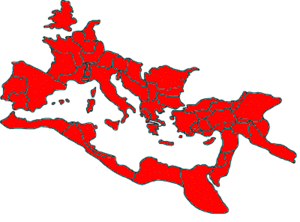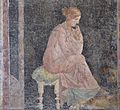Pax Romana facts for kids
The Pax Romana was a long time of peace and stability in the Roman Empire. "Pax" means "peace" in Latin, and "Romana" means "Roman." So, "Pax Romana" means "Roman peace."
This special time lasted for about 200 years. It began in 27 BC and ended in 180 AD. It started when Augustus became the first Emperor (ruler) of the Roman Empire.
Contents
What Was the Pax Romana?
The Pax Romana was a period when the Roman Empire was very strong and had few big wars. Even though it wasn't always perfectly peaceful, it was a "golden age" for Rome. During this time, the empire became very rich. No major threats challenged Rome's power in Europe, North Africa, or the Middle East.
Why Was it a Golden Age?
During the Pax Romana, many good things happened:
- There were not many large wars, which helped people live safely.
- There was a lot of trade. This means people bought and sold many goods (things like food, clothes, and tools) across the empire. This made everyone wealthier.
- The empire grew a lot in areas like architecture (building amazing structures), science, and mathematics.
Important Emperors of the Pax Romana
Several emperors ruled during this peaceful time. They each helped the empire grow and stay strong.
Augustus (27 BC – 14 AD)
Augustus was the very first Roman emperor. He was the great-nephew of Julius Caesar. He set up the system that brought peace and stability to the empire.
Nerva (96–98 AD)
Nerva made changes to land laws to help poor people. He also changed how taxes were collected.
Trajan (98–117 AD)
Trajan made the Roman Empire its biggest ever! He also built many new public works. These included bath-houses and roads that helped people travel and trade.
Hadrian (117–138 AD)
Hadrian built Hadrian's Wall in Britain (which was called Britannia back then). He also made Roman laws easier for everyone to understand.
Antoninus Pius (138–161 AD)
Antoninus Pius encouraged art and science. He also built new public works. He passed laws to help orphans (children who had lost their parents).
Images for kids
-
Extent of the Roman Empire under Augustus. Yellow shows the Republic in 31 BC, green shows new lands under Augustus, and pink shows client states.
-
An ancient coin of Gordian III from 243–244 AD, with "Pax Augusta" (Augustan Peace) on the back.
-
Fresco of a relaxed seated woman from Stabiae, 1st century AD.
See also
 In Spanish: Pax Romana para niños
In Spanish: Pax Romana para niños





